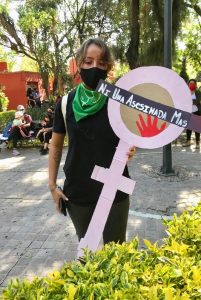Among the events here in San Miguel de Allende, Mexico, that marked this year’s International Women’s Day on March 8th which I attended were a peaceful march by young Mexican women, an art installation at Fabrica la Aurora, and a dramatic outdoor display of close to one hundred donated red dresses hanging on long clothes lines representing “Las Desaparecidas” (the disappeared).

At the Parque Juarez kiosk a group of young female activists gathered at four o’clock in the afternoon on March 8th to make and display the posters they would carry on their peaceful march to the city’s central Jardin later that afternoon. Organized by the Sororas y Rebeldes SMA collective, these women, dressed mostly in black, were part of a larger effort in Mexico called 8M (the 8th of March) to protest violence against women on this International Women’s Day.

At the Van Doren gallery in the Fabrica la Aurora art and design center, activist, photographer, and art psychotherapist Kate Van Doren, in partnership with Ser Mujer SMA, an organization dedicated to women’s empowerment and the fight against domestic violence, abuse, and femicide, created a multimedia art installation, “Honoring the Disappeared,” that includes more than one hundred photographs of mostly indigenous women and their stories. This exhibit opened on March 5thand will run throughout March, Women’s History Month.

And at three o’clock on March 8th, at the outdoor café Geek & Coffee next to Fabrica la Aurora, people began to gather to see all the red dresses being hung on clothes lines to honor and remember the one hundred and thirty-one women who have disappeared from San Miguel’s home state of Guanajuato since 2020.

Why, you may ask, only red dresses? I’m guessing it’s because red is the most attention-getting of colors, and violence against women demands much more attention. Red is the color of blood, of lipstick, of anger, of Valentine’s hearts, of fire engines, of stop lights. Red forces us to pay attention and take action.
According to an article by Carole Schor in last week’s local bilingual weekly newspaper Atención, “Femicide and the disappearance of women and young girls has been rampant in Mexico for decades. The national statistics agency’s (INEGI) surveys show that two-thirds (66%) of women in Mexico have experienced some form of abuse or violence.”
But it’s important to note, I believe, that such crimes against women and girls are not endemic to Mexico, or so-called “third world” countries. They are universal. Even in the great Land-of-the-Free-and-Home-of-the-Brave-with-Liberty-and-Justice-for-All, inequality and injustice toward women are rife.
Worldwide, countless women have stories of private atrocities and losses they are too ashamed or embarrassed to tell. After all, who listens? Lone voices can get drowned out in the cacophony of modern life, I know:
When I was young and my daughter was missing, I visited the office of the FBI agent handling my case as often as I could get there. He was a nice man, middle-aged, with short-cropped graying hair, a good-Irish-Catholic-family-man- type, named McCarthy, as I vaguely recall. He was tolerant of me and my uninvited appearances, my hand-wringing, my weepy pleas for news of any progress in finding my baby daughter and her abductor, her father, who was running from the law.
But one day, which turned out to be the last day I went to see Agent McCarthy, he said to me, bending over his desk, towering over me – and I recall this clearly, as if he’d taken out a pocket knife and carved the words into my skin: “You must remember you are just a number in our files.”
So I know what it’s like to see red.
That was the late 1960s. It wasn’t until 1977 that the United Nations declared March 8thInternational Women’s Day – not just a day to celebrate women’s achievements, but also to raise more awareness about women’s issues and concerns.
One powerless woman alone, I’ve learned, can easily be silenced, put in her place, be told she doesn’t matter much (“just a number in our files”). But great numbers of women standing up, marching together, raising their voices in protest against violence and injustice, demanding to be seen and heard through creative arts and art installations can effect changes.
Picture the hordes of angry French countrywomen on the streets of Paris — pitchforks in hand, demanding bread for their families — who sparked the French Revolution.
Now picture all these red dresses, hanging silently, limply, empty. The women who could wear them to happy life events – maybe on dates or to dances or fiestas, wearing matching red lipstick and heels — are missing. Gone. Perhaps forever. Let’s hope that none of us ever again sees a red dress the same way we used to. Let’s hope we all get the universal message in bright red.

~ ~ ~ ~ ~ ~ ~
For more information about the women’s organization Ser Mujer SMA and what they are doing to raise awareness of women’s issues this month, go to: www.sermujersma.com
Also visit the Global Women’s Caucus’s extensive Women’s History Month “living library,” which includes background information, historical facts, biographies and links to online events and exhibits.
To learn more about my daughter’s abduction and how I found her, read Somewhere Child (Viking Press, 1981).
